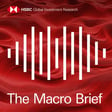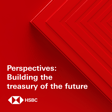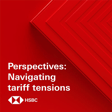Become a Creator today!Start creating today - Share your story with the world!
Start for free
00:00:00
00:00:01

The ESG Brief - What are Scope 3 emissions and why do they matter?
Wai-Shin Chan, Head of ESG Research at HSBC, looks at the growing awareness of Scope 3 emissions among corporates and investors and what regulators are doing to encourage their disclosure
Disclaimer. To stay connected and to access free to view reports and videos from HSBC Global Research click here
Hosted on Acast. See acast.com/privacy for more information.
Transcript
Introduction to HSBC Global Viewpoint
00:00:02
Speaker
Welcome to HSBC Global Viewpoint, the podcast series that brings together business leaders and industry experts to explore the latest global insights, trends, and opportunities.
00:00:13
Speaker
Make sure you're subscribed to stay up to date with new episodes.
00:00:16
Speaker
Thanks for listening.
00:00:17
Speaker
And now onto today's show.
00:00:24
Speaker
The following podcast was recorded for publication on the 1st of August.
00:00:28
Speaker
All the disclosures and disclaimers associated with this podcast must be viewed on the link attached to your media player.
What is the ESG Brief and who is Wei Xin Chen?
00:00:36
Speaker
Welcome everybody to the ESG Brief from the team here at HSBC Global Research.
00:00:40
Speaker
I'm your host, Jack Reed, and in this edition we are joined by our Head of Environmental, Social and Governance Research, Wei Xin Chen.
Understanding Scope 1, 2, and 3 Emissions
00:00:48
Speaker
Today we're talking about the disclosure by companies of their Scope 3 climate emissions.
00:00:53
Speaker
What are Scope 3 emissions and how widely disclosed are they?
00:00:57
Speaker
Well, Wei Xin is here to explain this less developed, perhaps, but no less exciting aspect of climate disclosure.
00:01:04
Speaker
Wei Xin, welcome.
00:01:05
Speaker
Thank you very much, Jack.
00:01:07
Speaker
Yes, I think Scope 3 emissions are extremely exciting.
00:01:09
Speaker
So very good to be here.
00:01:11
Speaker
Let's start with the definitions.
00:01:13
Speaker
What are Scope 1, 2 and 3 emissions?
00:01:17
Speaker
Absolutely.
00:01:18
Speaker
Scope 1 emissions are the direct emissions from, say, the combustion of fossil fuels.
00:01:23
Speaker
So if you are a coal-fired power plant, all the coal that you burn, that is your scope 1 emissions.
00:01:29
Speaker
Scope 2 emissions are indirect emissions.
00:01:32
Speaker
So the emissions generated from the consumption of electricity and heat, so the purchases of electricity, and it would require to know the carbon intensity of that electricity production.
00:01:44
Speaker
Now scope 3 is everything that is not included in scope 1 and scope 2.
00:01:49
Speaker
So it is the full value chain emissions that a company has possibly a bit of influence over, a bit of control over, right upstream from the beginning, the extraction, the production and transportation of materials, right down to the downstream, the consumption of the products and services, as well as the end of life.
00:02:08
Speaker
So a very, very broad swathe of emissions there.
00:02:11
Speaker
So lots of emission sources there, but not a lot of emissions that companies are actually talking about.
Challenges and Complexities of Scope 3 Emissions
00:02:18
Speaker
So many, many companies are now disclosing their carbon emissions.
00:02:22
Speaker
Definitely scope one, that's fairly easy to calculate.
00:02:25
Speaker
Scope two is easy if you know the carbon intensity of the electricity purchases.
00:02:31
Speaker
The disclosure rates for scope one and scope two emissions have been improving, and that's because the regulatory requirements of various jurisdictions
00:02:42
Speaker
are there for them to disclose their emissions but very very few actually require scope 3 emissions disclosures scope 3 is where it becomes complicated and at the same time scope 3 emissions can often account for the largest share or part of corporate related emissions if we take the oil and gas industry for example they have direct emissions in the extraction of their of their fossil fuels
00:03:09
Speaker
They have probably less indirect emissions on the scope two, the operations for example, but the vast majority of emissions from a scope three perspective for an oil and gas company is when the end users, so car users and gas users commercially use their products.
00:03:29
Speaker
And that is definitely the largest share in terms of an oil and gas company.
00:03:35
Speaker
And where is the data coming from that you've been looking at?
00:03:39
Speaker
Scope 3 emissions are quite hard to combine.
00:03:43
Speaker
Not that many companies disclose it voluntarily.
00:03:46
Speaker
There are a few organizations which aggregate this.
00:03:49
Speaker
So the CDP, formerly known as the Carbon Disclosure Project, tells us which companies in their disclosure regime have Scope 3 emissions.
00:03:59
Speaker
The S&P Global 1200 Index actually has some interesting information on scope 3 emissions, and we can see through a lot of the different sectors that are a part of that, that scope 3 emissions are most often not disclosed by the companies in this index.
00:04:18
Speaker
And I suppose the research into this is complicated by the fact that there are so many sources of these so-called scope 3 emissions, both upstream and downstream.
00:04:29
Speaker
That's absolutely correct, Jack.
00:04:31
Speaker
There are actually around 15 categories of Scope 3 emissions, which makes it quite challenging to sort of find a breakdown on.
00:04:39
Speaker
If we think about the eight upstream categories, things like purchase goods and services, waste generated in operations and upstream leased assets.
00:04:48
Speaker
And when we look at downstream, we've got investments, franchises,
00:04:52
Speaker
end-of-life treatment.
00:04:54
Speaker
Not every company will be gathering the appropriate information in terms of emissions for all those different categories.
00:05:02
Speaker
So it makes comparing scope 3 emissions between one company and another very, very challenging indeed.
Why are Scope 3 Emissions Important for Investors?
00:05:09
Speaker
Now in July you published a really comprehensive report on this topic and I'd like to come on to some of the feedback that you've received a little bit later on.
00:05:19
Speaker
But you refer to Scope 3 emissions in the title of the report as the largest piece of the net zero jigsaw.
00:05:27
Speaker
Why is it so important in your view?
00:05:29
Speaker
It's important for investors and other stakeholders to be aware of Scope 3 emissions because it helps them to better assess the potential risks and opportunities with the companies they invest in.
00:05:41
Speaker
For example, if a company has a large exposure to upstream emissions in their Scope 3,
00:05:48
Speaker
If there is a tightening of regulations or an increase in the carbon price, they would be better able to assess the effect on the company's potential costs if the carbon price goes up.
00:06:00
Speaker
At the same time, many, many companies that have net zero targets do not include scope three emissions within their net zero targets.
00:06:08
Speaker
So they're only implementing corporate strategies to reduce their scope one and scope two emissions.
00:06:14
Speaker
And that can give rise to the perception
00:06:17
Speaker
of greenwashing, which is never a good thing.
Regulatory Oversight on Scope 3 Emissions
00:06:20
Speaker
So if greenwashing is a risk here, what are regulators doing to minimize that?
00:06:24
Speaker
So historically, there hasn't been that much regulatory oversight of Scope 3 emissions, but that's definitely changing.
00:06:31
Speaker
We think that Scope 3 disclosures from a regulatory point of view are on the horizon.
00:06:36
Speaker
We see that coming in, for example, in Singapore, in New Zealand.
00:06:42
Speaker
It's being proposed for a couple of years' time.
00:06:44
Speaker
I think it's 2024 for the European Union.
00:06:47
Speaker
And it was something that the SEC in the US mentioned, even though there was quite a lot of pushback.
00:06:52
Speaker
from companies.
00:06:52
Speaker
So it is entering the mindshare of regulators.
00:06:57
Speaker
At the same time, central banks have begun to include Scope 3 in their climate stress tests to see how resilient the financial system overall would be to a climate shock or anything like that.
00:07:09
Speaker
So it's definitely on the horizon for many, many companies and many, many economies.
00:07:16
Speaker
Weixin, among investors, how well understood are these Scope 3 emissions?
00:07:21
Speaker
The awareness has grown amongst the general investment community, but given the strong support we've had for this report after it came out, I think the awareness could always be improved.
00:07:34
Speaker
This is not just for the investment community, but also for the corporates themselves.
00:07:38
Speaker
it is definitely more challenging to disclose upon Scope 3 emissions because of the challenges of boundary setting, the challenges of timeframe, etc.
00:07:49
Speaker
So it's a while before we get a decent level of awareness and engagement, but we've seen a growth in the number of both companies and investors asking us questions about Scope 3 emissions.
00:08:04
Speaker
Two of the companies that you cite in the report for their level of disclosure are Alphabet and Google.
00:08:11
Speaker
What lessons do we learn from what they have to say about Scope 3 emissions?
00:08:17
Speaker
In our report, we highlight that Microsoft and Alphabet are one of the few companies that did give a breakdown of their scope 3 emissions to quite a bit of detail.
00:08:26
Speaker
From memory, it was eight, nine, or 10 categories disclosed, which is very, very good.
00:08:31
Speaker
The interesting takeaway there is that Microsoft and Alphabet, although they are similar companies in a very, very similar sector, the different categories which they chose to disclose upon for their scope 3 emissions
00:08:47
Speaker
were different, which means that actually getting comparability and consistency between two companies in the same sector is very, very challenging.
00:08:55
Speaker
One of the quirks of Scope 3 emissions is that they can occur over different time boundaries.
00:09:00
Speaker
For example, if you're looking at purchased goods and services, they may not necessarily have been made in the current year.
00:09:07
Speaker
They may be historical.
00:09:09
Speaker
And if we're looking at the end of life of your particular product,
00:09:12
Speaker
You have to make a guess as a company as to when that will happen.
00:09:15
Speaker
It will happen in the future, but will that be this reporting year or in a few years to come?
00:09:21
Speaker
So it's not easy for that comparison to be made, but it's a great start for companies to start to collect the data, to measure their exposure and begin to disclose that to the general public.
Greenhouse Gas Protocol and Emerging Categories
00:09:35
Speaker
And just in terms of background, who decides what's in scope for scope one, two, and three disclosures?
00:09:44
Speaker
So the scope one and the scope two and the scope three missions are defined by the Greenhouse Gas Protocol, an organization that was set up between the World Resources Institute, the WRI, and the World Business Council on Sustainable Development.
00:09:58
Speaker
And that WBCSD is the reason why most companies, when they're looking at their greenhouse gas emissions,
00:10:06
Speaker
accounting.
00:10:06
Speaker
They use the greenhouse gas protocol.
00:10:08
Speaker
So they are the ones, the organization, are the ones that have defined these 15 categories and they will continue to evolve.
00:10:16
Speaker
We don't think they cover absolutely everything.
00:10:18
Speaker
There have been a number of companies that have actually complained that they think there should be more categories.
00:10:23
Speaker
So we think there will be a continual evolution as more companies disclose on their scope three and more stakeholders say, well, this is
00:10:32
Speaker
not quite adequate.
00:10:33
Speaker
It doesn't tell us the entire picture.
00:10:35
Speaker
So this is something that will continue to evolve, but it will most likely fall under the greenhouse gas protocol.
00:10:43
Speaker
That's great, Weishan.
00:10:44
Speaker
Thank you very much.
00:10:45
Speaker
All super interesting to learn from you.
00:10:46
Speaker
Final question, is there a sequel?
00:10:49
Speaker
Funny you should ask that, Jack.
00:10:50
Speaker
There is actually something emerging called scope for emissions, which refer to emissions that no longer occur as a result of a certain activity by an entity.
00:11:00
Speaker
So they're often known as avoided emissions.
00:11:04
Speaker
However, there is no universal definition or accounting standard for scope for emissions.
00:11:08
Speaker
So it's probably something we will leave for another time.
00:11:12
Speaker
Weixin, thanks very much for your time.
00:11:14
Speaker
Thank you very much for having me, Jack.
00:11:16
Speaker
Always a pleasure.
00:11:18
Speaker
That's all the time we have for this edition.
Where to Listen to HSBC Global Viewpoint
00:11:20
Speaker
If you are listening to this podcast from a website, remember the ESG Brief and our macro podcasts, including our newest series from Asia called Under the Banyan Tree, are available on Apple and Spotify podcast channels.
00:11:34
Speaker
Just search for HSBC Global Viewpoint and you'll find us there.
00:11:38
Speaker
Thanks very much for listening.
00:11:39
Speaker
We'll be back soon.
00:12:00
Speaker
Thank you for joining us at HSBC Global Viewpoint.
00:12:04
Speaker
We hope you enjoyed the discussion.
00:12:06
Speaker
Make sure you're subscribed to stay up to date with new episodes.

















